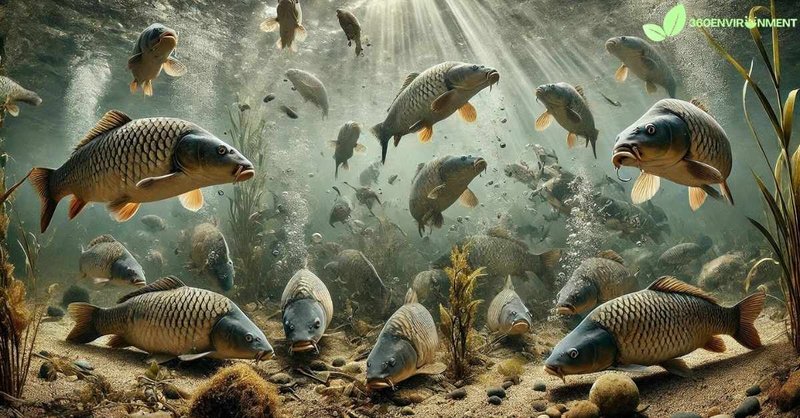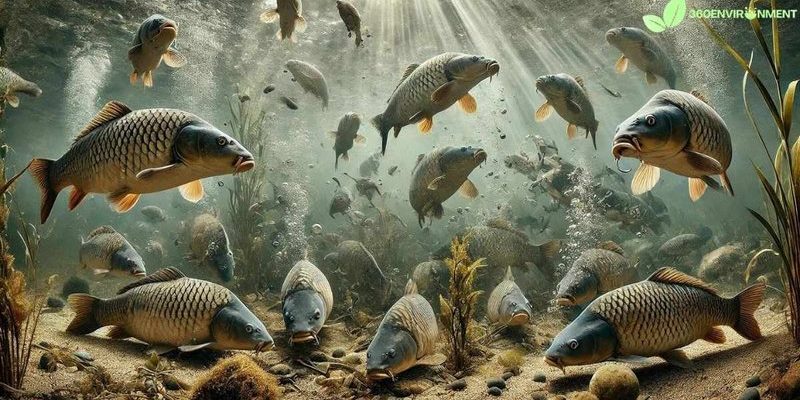
Feeding carp is kind of like trying to find the perfect meal for a picky eater—there’s a balance between offering them something they love and making sure it’s good for them. Trust me, understanding what carp eat and creating a feeding schedule can make all the difference in their health and growth. So, let’s dive in!
Understanding the Carp’s Diet
Carp are omnivorous fish, which means they couldn’t care less about sticking to just one type of food. They happily munch on a mix of plants, insects, and small creatures. Imagine them as the buffet lovers of the fish world! In the wild, carp snack on:
- Plants: Water lilies and algae are like fast food for them.
- Insects: Bugs and larvae provide a protein boost.
- Small Fish: They won’t shy away from a little protein shake in the form of smaller fish.
Carp are particularly good at foraging, often rooting around the bottom of lakes and ponds for their meals. They use their sensitive lips to snuffle through the substrate, looking for hidden treats. So, whether it’s tasty greens or crunchy insects, they’re always on the hunt for food.
The Best Foods for Carp
Now that we know carp are flexible eaters, you might be wondering what the best foods for them are, especially if you’re taking care of them in a pond or aquarium. Here’s the thing: not all fish foods are created equal. You want to make sure you’re choosing options that keep your carp healthy and happy.
1. Commercial Fish Food: Look for floating pellets or sticks specifically designed for carp. These often contain a balanced mix of nutrients that promote growth and health.
2. Vegetables: Dark leafy greens like spinach or lettuce make excellent treats. Just make sure to chop them up a bit so your carp can easily nibble on them.
3. Fruits: Believe it or not, carp love fruits! You can toss in slices of oranges or melons, but watch how much you give them since these are high in sugar.
4. Live Food: If you want to replicate their natural diet, consider offering live food like worms, maggots, or insects. They’ll go wild for these!
It’s essential to mix things up to keep your fish interested and ensure they’re getting a variety of nutrients.
Creating a Feeding Schedule
You might be thinking, “Great! But how often should I feed my carp?” A feeding schedule can play a key role in their health and growth. Here’s a simple guide to help you get started.
Daily Feeding: Aim to feed your carp once or twice a day. You don’t want to overwhelm them with food—think of it as giving them just enough to keep them satisfied without stuffing them full.
Seasonal Adjustments: Carp’s appetite can change with the seasons. During warmer months, they might eat more, while in cooler temperatures, they may slow down.
Monitor Their Behavior: Keep an eye on how your carp respond. If they’re gobbling up everything quickly, you might consider increasing the amount a bit. If food is left uneaten, you may want to reduce it.
Remember, it’s always better to underfeed than overfeed. A clean pond is critical for their health, and excess food can lead to water quality issues.
Nutritional Needs for Healthy Growth
Just like we need a balanced diet, carp also require a mix of nutrients to stay healthy. Here’s what to keep in mind for their nutrition:
– Proteins: Essential for growth, especially in young carp. Look for foods high in protein, especially if you’re raising them.
– Fats: Good fats support energy and help their bodies function correctly. Fish meals and oils can be great sources.
– Vitamins & Minerals: These help with overall health. Check the nutrient content in your fish food and consider adding supplements if necessary.
Feeding carp properly ensures they not only grow healthily but also resist diseases more effectively.
Common Feeding Mistakes to Avoid
Even seasoned fish keepers can make mistakes when it comes to feeding carp. Here are a few common pitfalls to watch out for:
1. Overfeeding: It’s easy to think more food equals happier fish, but overfeeding can lead to serious health issues like obesity and poor water quality.
2. Ignoring Water Quality: If you feed improperly, it can lead to leftover food rotting and polluting the water. This can stress your fish and contribute to disease.
3. Not Offering Variety: Feeding the same thing daily can lead to nutritional deficiencies. Mix it up to ensure they get all the necessary nutrients.
4. Feeding During Cold Weather: When the water gets very cold, carp’s metabolism slows down. They may not eat at all during these times, so skip feeding or offer very small amounts.
By paying attention to these points, you can have a healthier and more vibrant aquatic environment for your carp.
Feeding Carp in Different Environments
The way you feed carp can vary depending on where they are. Whether in a pond, lake, or aquarium, it’s essential to adapt your approach.
Pond Feeding: In a natural pond, carp can scavenge and find their food, but supplementing their diet is still helpful. Use floating pellets that disperse across a wide area to encourage foraging.
Aquarium Feeding: In a closed environment like an aquarium, you have more control over their diet. Offer both dry and live foods while being mindful of the water quality.
Lake Fishing: If you’re trying to attract carp for fishing, consider using a bait mix that mimics their natural diet. Corn, dough balls, and pellets work wonders.
Adjust your feeding techniques based on the specific environment to create a thriving habitat for your fish.
Caring for carp can be a rewarding experience, especially when you see them thriving under your care. By understanding what they eat, creating a thoughtful feeding schedule, and meeting their nutritional needs, you can ensure they remain healthy and vibrant. Remember, the key to happy carp is variety, balanced nutrition, and mindfulness about their eating habits. So, whether you’re a pond owner or just fascinated by these fish, giving them the right food can make all the difference!

